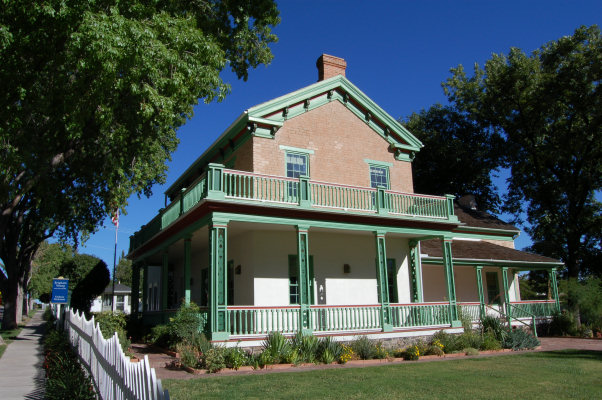Brigham Young Winter Home and Office
Soon after members of The Church of Jesus Christ of Latter-day Saints settled the Salt Lake Valley, church president Brigham Young began sending families to settle other areas of the territory and environs. St. George, Utah, was settled in 1861. The early residents found the hot, dry area of the Santa Clara and Virgin Rivers almost unmanageable and unlivable. To help those early settlers stay and establish the area, President Young instigated a public works project. Northern Utah residents donated or tithed food and other supplies while Southern Utah residents worked. The St. George tabernacle, courthouse, and eventually the St. George Utah Temple were built through this project.
Church leaders were accustomed to traveling throughout the state to visit the settlements and oversee the local church leaders and members. As both governor of the Utah territory and president of the Church of Jesus Christ, Brigham Young visited St. George frequently. As he aged, he began suffering from arthritis and found the warm, dry, snowless area of St. George beneficial for his health. Young began going south for the winter—locals call him St. George’s first snowbird.
Young first bought the home of James Chesney. He later decided to build a larger home with an office, large barn, garden, and vineyard. The original part of the home was started in 1869 and completed two years later. A front addition, the main part of the house, was completed in 1873.
The two-story home is constructed of adobe from plaster, local mud, and local rock. Visitors to the home can still see where the adobe bricks contain the outlines of the sagebrush used to stabilize it. The walls are thick to insulate the home, and it features a large wrap-around porch. Many Utah homes at that time featured a vegetable storage room in the basement. To help with the heat, the home had a ventilation system that allowed warm air to rise and escape through the ceiling, then attic, and then out of the house. In addition to three or more bedrooms, the upstairs master bedroom was large and office-style. The home also had a detached office with a telegraph station.
The exterior is painted colors thought to be the original colors. The landscaping consisted of orchards and gardens on three sides. A mulberry tree in the yard supplied leaves for feeding silk worms, reflecting the period of time when the women of the church cultivated the trees for a silk industry. The garden continues to produce cotton and grapes, both industries of the early settlers.
Brigham Young was born in 1801 in Vermont. Rather than import hardwood from his native New England, he harvested logs from the Pine Valley Mountains or from Mount Trumbull, which was several days' journey to the south of St. George. As done in Brigham Young’s other homes, the soft pines of the doors, tables, and windowsills were painted to simulate the hardwoods of New England. Wood was also painted to look like quarried stone. Young was a furniture maker and he constructed rockers and chairs for his homes.
Some of the original furnishings stayed with the home throughout the years and some pieces were replicated when it was restored. Young’s descendants donated some of the pieces. The interior of the Brigham Young Winter Home is exhibited as Young would have designed it.
Several people owned the home after Young’s death in 1877. Young’s descendant Georgius Cannon Young deeded it to the Utah State Parks and Recreation in 1959. In 1975, the home was traded to The Church of Jesus Christ of Latter-day Saints for the Brigham Young Forest Farmhouse. It is listed on the National Register of Historic Places.
Brigham Young’s Winter Home is nestled in a neighborhood of pioneer homes, many of which are also restored. The home is located at 200 North and 100 West and open for tours.
